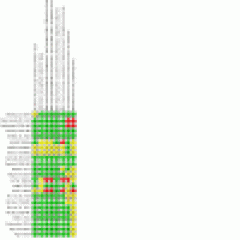Filter by

Bacterial Pathogenesis and Antibacterial Control
Abstract Bacterial pathogens have been becoming the main problem in hospital and community-acquired infections. It is hard to treat the strains that are resistant to antibiotics, due to the causing recurrent and untreatable infections. In recent years, the combination treatments and the novel technologies have been preferred to overcome the emergence of antibacterial resistance of pathogens. I…
- Edition
- -
- ISBN/ISSN
- , 9781838813055
- Collation
- -
- Series Title
- -
- Call Number
- -

Bacterial NanoCellulose
Abstract Bacterial nanocellulose (BNC) is an emerging nanomaterial with unique properties produced by several species of ubiquitous fermentation bacteria, most importantly Gluconacetobacter xylinus, previously known as Acetobacter xylinum. BNC has been used for a variety of commercial applications including textiles, cosmetics, and food products, and it has a high potential for medical applica…
- Edition
- -
- ISBN/ISSN
- -
- Collation
- -
- Series Title
- -
- Call Number
- -

Bacterial Mechanisms of Antibiotic Resistance: A Structural Perspective
Abstract This eBook is a collection of articles from a Frontiers Research Topic. Frontiers Research Topics are very popular trademarks of the Frontiers Journals Series: they are collections of at least ten articles, all centered on a particular subject. With their unique mix of varied contributions from Original Research to Review Articles, Frontiers Research Topics unify the most influential …
- Edition
- -
- ISBN/ISSN
- 9782889631902
- Collation
- -
- Series Title
- -
- Call Number
- -

Bacterial Infectious Diseases Annual Volume 2023
Abstract Despite the development of numerous antimicrobial agents, the successful eradication of bacterial infections remains a challenge, and bacteria continue to pose a major public health threat. It is estimated that, due to the increasing prevalence of antibiotic resistance, infectious diseases will become a leading cause of death by 2050. The current annual focus is on the challenges and …
- Edition
- -
- ISBN/ISSN
- 9780850142549
- Collation
- -
- Series Title
- -
- Call Number
- -

Bacterial Cell Wall Structure and Dynamics
Abstract This eBook is a collection of articles from a Frontiers Research Topic. Frontiers Research Topics are very popular trademarks of the Frontiers Journals Series: they are collections of at least ten articles, all centered on a particular subject. With their unique mix of varied contributions from Original Research to Review Articles, Frontiers Research Topics unify the most influential …
- Edition
- -
- ISBN/ISSN
- 9782889631520
- Collation
- -
- Series Title
- -
- Call Number
- -

Bacterial Cattle Diseases
Abstract This book discusses important bacterial diseases and suggestive prevention strategies based on progress in this field. It includes four sections and five chapters that provide the most common diseases and an overview of the essential methods for their prevention and control.The book will be useful to researchers and students of veterinary sciences as well as those who are interested i…
- Edition
- -
- ISBN/ISSN
- 9781838812317
- Collation
- -
- Series Title
- -
- Call Number
- -

Baclofen in the Treatment of Alcohol Use Disorder
Abstract This eBook is a collection of articles from a Frontiers Research Topic. Frontiers Research Topics are very popular trademarks of the Frontiers Journals Series: they are collections of at least ten articles, all centered on a particular subject. With their unique mix of varied contributions from Original Research to Review Articles, Frontiers Research Topics unify the most influential …
- Edition
- -
- ISBN/ISSN
- 9782889459674
- Collation
- -
- Series Title
- -
- Call Number
- -

Background and Management of Muscular Atrophy
Abstract A healthy skeletal musculature is necessary for a good quality of life and is important in sports. The loss of skeletal muscle mass leads to severe clinical complications and alters daily functioning. The aim of this book is to give an overview of skeletal muscle atrophy including pathomechanism, clinical characters, and the tools for prevention and treatment. Skeletal muscle atrophy …
- Edition
- -
- ISBN/ISSN
- 9781838807269
- Collation
- -
- Series Title
- -
- Call Number
- -

Back to the Future: On the Road Towards Precision Psychiatry
Abstract This eBook is a collection of articles from a Frontiers Research Topic. Frontiers Research Topics are very popular trademarks of the Frontiers Journals Series: they are collections of at least ten articles, all centered on a particular subject. With their unique mix of varied contributions from Original Research to Review Articles, Frontiers Research Topics unify the most influential …
- Edition
- -
- ISBN/ISSN
- 9782889636617
- Collation
- -
- Series Title
- -
- Call Number
- -

Back to the Future. The Future in the Past. Conference Proceedings Book
Abstract ICDHS is the acronym of the International Committee of Design History and Design Studies, an organisation that brings together scholars from Spain, Cuba, Turkey, Mexico, Finland, Japan, Belgium, the Netherlands, Brazil, Portugal, the US, Taiwan, Canada and the UK. Since 1999, when the Design and Art History departments of the University of Barcelona organised the first edition of …
- Edition
- -
- ISBN/ISSN
- 9788491681717
- Collation
- -
- Series Title
- -
- Call Number
- -
 Computer Science, Information & General Works
Computer Science, Information & General Works  Philosophy & Psychology
Philosophy & Psychology  Religion
Religion  Social Sciences
Social Sciences  Language
Language  Pure Science
Pure Science  Applied Sciences
Applied Sciences  Art & Recreation
Art & Recreation  Literature
Literature  History & Geography
History & Geography